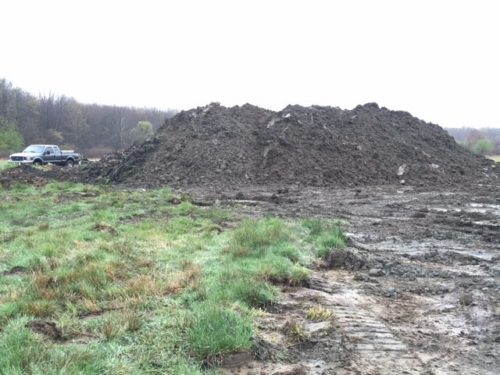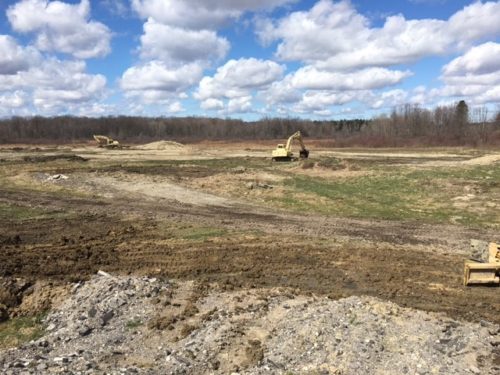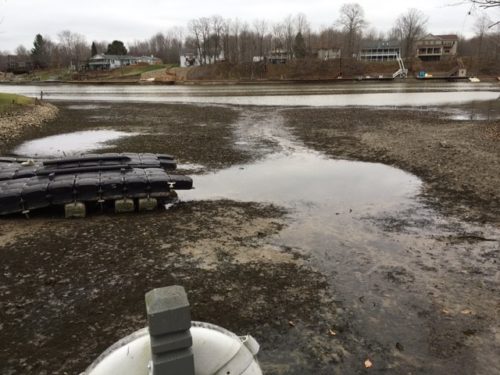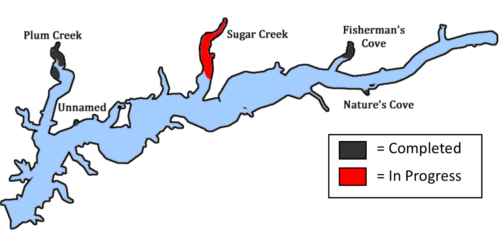Green lawn, healthy lake
 By Richard D. Gainar, CEBS – Lake Management Committee
By Richard D. Gainar, CEBS – Lake Management Committee
Nutrients, primarily nitrogen and phosphorus, are key ingredients in lawn fertilizer. When it rains, fertilizer applied to lawns can wash into nearby storm culverts and streams that flow into our lake. Nutrients contribute to algae blooms, excess weeds, rob the water of oxygen, and threaten underwater life.
Best management practices for the health of your lawn and Lake Roaming Rock:
- Skip the spring fertilizer, especially if your lawn is healthy. Fertilizing lawns in spring promotes excessive top growth at the expense of roots.
- Sharpen lawnmower blades. A dull blade tears and weakens the grass, opening it up to disease. Many local hardware stores or garden shops can sharpen your blade for you.
- Raise the cutting height of the mower. Taller grass shades out weeds and needs less water. A three-inch cut length is ideal for most lawns.
- Leave grass clippings on the lawn. They provide free fertilizer all season long.
If fertilizer is necessary:
- Follow the directions on the fertilizer bag.
- Learn about soil testing.
- Do not apply phosphorus to lawns unless a soil test indicates that it is needed.
- Clean up any fertilizer on driveways or other impervious surfaces.
- Keep fertilizer applications 10 to 15 feet away from waterways.
- Do not apply fertilizer if heavy rain is expected.
Love the Lake and be lake responsible.
Goosebusters: Good job so far!
 By Richard D. Gainar, CEBS – Lake Management Committee
By Richard D. Gainar, CEBS – Lake Management Committee
I have begun to see goslings hatching out around May 1st. We did a pretty good job neutralizing the goose nests that were located earlier thanks to the support and reports we received from many concerned residents. Now and through June is the time to be vigilant in watching for goslings and begin harassing them the day they show up. The longer you wait, the harder our job is to get rid of them.
According to Geoffery Westerfield of the ODNR, harassing the goslings is very important for limiting the number of resident geese on our lake during the rest of the year. Separating the goslings from their parents even for a short time is an effective form of harassment. Geoffery advises that whenever you can, try to separate goslings from the adult geese by stepping between them shooing the goslings away from the adults by waving your arms and making loud noises (do not make contact). If you harass the goslings and adults together it is less effective and can even be counterproductive. Your goal is to send the message to the adult geese that your property is not a safe place to raise their young and to the goslings that Lake Roaming Rock can be a scary place.
“Don’t stop anywhere short of the geese leaving your property”, says Geoffery. Simply chasing them to the water or the neighbor will not keep the geese off of your property (and is actually also counterproductive). Consistency and persistency is still key. Geese will “shift” around the property, especially those without goslings. Keep up the consistent and persistent harassment.
June 1st is an important date. Geese will begin to molt (i.e. lose their flight feathers) around June 1st. If you don’t harass them off the property by that date, it becomes very difficult to remove them and you will likely be stuck with the geese till mid-July.
Geese excrement is a contributor to the E. coli levels in our lake. In addition, it provides excess nutrients that feed the algae and weeds. We love our geese, but a few less wouldn’t hurt either. Thanks for being lake responsible!
What to Doo about Pet Waste
 By David Ernes – Lake Management Committee
By David Ernes – Lake Management Committee
You have heard many statements linking manure from farm animals, and manure spread on agricultural fields to increasing phosphorous in our lakes and streams. But are you aware that waste from our pets can also be a source for nutrients as well as disease-causing bacteria and parasites that can get into our lake? In some articles, dog waste is cited as the third or fourth largest contributor of bacterial contamination in urban watersheds. Some estimates have an average dog generating a half to three-quarters of a pound of waste per day, or 270 pounds per year. Studies also indicate that 60% (or less) of pet owners pick up their pet’s waste. The EPA has indicated that 2-3 days of waste from just 100 dogs could generate enough pollution (nitrogen, phosphorous and bacteria such as E. Coli) to close a beach, and can affect the watershed for 20 miles.
In researching this article, I found some other interesting facts. Unlike manure from cows, who eat a grass-based diet, dogs are fed a protein-based diet, which results in a highly acidic waste that will kill the grass if not picked up. It is also estimated that dog waste can take up to one year to completely breakdown. The natural ecosystem can only process and absorb the waste from two average dogs per square mile. If the ecosystem cannot absorb the waste fast enough, the bacteria and nutrients will be carried by rain into the watershed, and ultimately any body of water nearby (like our lake).
What can you do? Pick up your pet’s waste. Even if the ground is snow covered, once thawed, the waste will still contribute to the problem. This is important not only on your yard but also in public areas (including RA lots), and on the street, where it can leach into the ditches along the roadways and end up in the lake. Remember, an unimproved lot is not an invitation for pet owners to skip the cleanup process. Once collected, most web sites recommend three options for disposal – flush down the toilet, bury in the yard, or dispose of in the trash. A “green” option often mentioned is composting. However, typical composting does not result in enough heat to totally destroy all harmful agents (bacteria, parasites) in the waste, so use caution. If the pet waste does end up in compost, it is recommended the compost not be applied to plants that will be eaten or are intended to be brought in to the home for decoration.
So if we “doo” the right thing, we can help reduce another controllable source of pollution to our lake. But don’t forget, a barking dog is a good deterrent for the Canadian geese that are also part of the problem. Several articles have been written on this issue.
BE LAKE RESPONSIBLE
The Lake in the Winter – Part 2
 By David Ernes – Lake Management Committee
By David Ernes – Lake Management Committee
A frozen lake is just one more sign that winter has come to Roaming Shores. It presents a snapshot in time of the beauty of the lake. Of course the lake does not completely freeze (thanks to the properties of water), and one never knows if we will even see the surface of the lake freeze this year. But if we do, you may be surprised at what goes on under the ice.
A lake’s “winter” season is often identified based on the dates that the lake becomes fully ice covered. Once the lake is frozen, the entire ecosystem changes to cope with the colder temperatures.
Of most importance to many of our residents is the effect on the fish population. Fish seek the warmer waters under the ice and can survive as long as the oxygen levels in the water are adequate. Since they are not warm blooded, their metabolism slows, including respiration, digestion and activity level. This state, called torpor, allows them to survive until the ice melts and the water starts to warm up again. Some amphibians survive in this state by first burrowing into the sediment along the lake bottom before “hibernating”.
Macrophytes (aquatic plants) can actually handle the winter better than their terrestrial cousins if they are protected under the water. Some will form nodules, which can store energy while they wait for the sun to reappear. Some may go dormant. Some may die back, but their root systems may survive to grow again in the spring. While the lake drawdown can kill even the root systems if exposed long enough to the cold air, hopefully many beneficial aquatic plants will survive as they compete with the algae for the nutrients in the spring and summer.
As far as microscopic organisms are concerned, they also adapt. Phytoplankton (photosynthetic organisms) such as cyanobacteria (blue-green algae), produce thick-walled cells much like a cocoon that will protect them in a dormant state until conditions are more favorable. Some species can survive by becoming cannibals and consuming other algae species for food. Zooplankton (microscopic animal that also eat phytoplankton) may also form a cocoon for protection.
Like some of us, the lake’s many residents slow down their activity level during the cooler winter months and wait for the arrival of spring.
(Some information presented in this article was extracted in part from Lakeline Vol 34, #4 (2014))
BE LAKE RESPONSIBLE
Our Beautiful Lake
 By: Richard D. Gainar, CEBS – Chairman, Lake Management Committee
By: Richard D. Gainar, CEBS – Chairman, Lake Management Committee

How long has it been since you just stopped whatever you were doing to simply look out over our beautiful lake? The winter snow may cause us some problems driving but it sure does paint a wonderful background for one of the most spectacular views along the shoreline of our lake. Whatever problems occupied my mind a few moments before simply disappear when I stare out over the water. I can’t think of another scenic view anywhere that rivals the one in our own backyard.
This time of year allows me to reflect on the past year of the many great memories we each create here in Roaming Shores. Whether it’s jumping from a floating dock at one of the beaches, watching the wonderful fireworks over East Beach or laughing with neighbors while the sun sets behind the trees. I give great Thanks to those committee members whom have donated precious hours to help better our community and lake through the Lake Management Committee. I urge others to consider getting involved with the Lake Management Committee and sharing your skills and talents in the coming year. From your RomeRock Association Lake Management Committee, we wish you a very happy, merry and safe Holiday Season.
Remember to Love the Lake and Be Lake Responsible
The Lake in the Winter – Part 1
 By David Ernes – Lake Management Committee
By David Ernes – Lake Management Committee
As Fall moves to Winter, we see more than the change in the color of the leaves. We see changes occurring on the lake – both natural and man-made. The first, which has already occurred, is the lake turnover. This phenomenon, generated as the lake water temperature equalizes top-to-bottom, results in mixing to temporarily eliminate stratification. A previous article was written which goes into more detail on this phenomenon.
The next change that you may see is the lake level lowering. If all is going as planned, the Village will proceed with opening the spillway to allow the lake water level to drop. As past years can attest, the success depends on the amount of rainfall we experience during the fall. Typically done to kill nuisance aquatic plants which we did not observe this year, it also accomplishes several other results. It removes some of the nutrient rich water, to be replaced with either clean snow melt or the spring rains. It also gives the lake ample capacity to accept the potentially heavy spring rains without causing problems due to flooding. If we can believe the long-range forecast for the coming winter, we may experience a warmer but wetter season. So, it may be a battle! If the models are wrong, lake lowering can, to some extent, protect shoreline structures from ice damage.
But also important is that with the water level lower we have an excellent opportunity for those of us with lakefront properties to inspect the shoreline. Erosion is a constant issue that, over time, can degrade the integrity of a dock, rip-rap (rock wall) or seawall. Look for holes or other types of damage in erosion control structures and seek remedies to reinforce them. Reinforcement of shoreline barriers, confirming clear drainage channels, and checking dock supports and surrounding areas safeguards your property as well as the other residents of Lake Roaming Rock.
With the water level low, it also gives the opportunity to do some self-dredging around your dock and seawall. However, make sure that you or your properly registered contractor has obtained the proper permits from the RRA before proceeding.
The next installment will go over what happens as the water continues to cool and ice forms.
BE LAKE RESPONSIBLE
Note on Advisory Signs
For those who visit our beaches, you will notice that the Algal Warning Signs are posted. These warning signs were posted due to readings taken on 8/21/17 which indicated algal toxin levels exceeded the EPA’s Public Health Advisory limit.
While the most recent tests indicated the algal toxin levels were well below the Elevated Advisory Limit, 2 readings under state guidelines are needed before the signs will be taken down.
| Microcystin Algal Toxin | E.coli Bacteria | |||
| West Beach 1 | East Beach 2 | West Beach 1 | East Beach 2 | |
| Results below early warning level | Results above early warning level | Results below early warning level | Results below early warning level | |
The Algal Toxin Levels from the Beach 2 slightly exceeded the EPA’s Public Health Advisory limit. However it is well below the Elevated Advisory Limit which would recommend no contact. All data can be found on the LMC section of the RRA website.
Current Conditions for Week of 8/28/2017: The current results for the testing program for the lake are summarized above. A green cell indicates that results are below the USEPA or OhioEPA criteria for recreational water. A yellow cell indicates that values have exceeded the limit and appropriate caution is advised. Your Lake Management Committee’s (LMC) water testing program for harmful algal blooms (Microcystin) monitors our two beach areas monthly during the hot, summer months and advises that all test results received so far have been well below any level of concern or alarm. In addition, the LMC is also having tests performed for the presence of E.coli bacteria weekly at the two beaches as is done in most public beaches. Should any of these test results approach the level of caution, the Board of Directors can request that caution signs be posted at the affected beaches for your safety. Of course, common sense tells us not to swim in any waters that contain unusual amounts of algae. Please enjoy our beautiful lake and have a safe summer.
What to Doo about Pet Waste
 By David Ernes – Lake Management Committee
By David Ernes – Lake Management Committee
One of the actions we can do to protect our lake is pick up after our dogs. Some estimates have an average dog generating ¾ of a pound of waste per day, or 270 pounds per year. Studies also indicate that only 60% of pet owners pick up their pet’s waste. The EPA has indicated 2-3 days of waste from 100 dogs could generate enough pollution (nitrogen, phosphorous and bacteria such as E. Coli) to close a beach, and affect the watershed for 20 miles.
In researching this article, I found some interesting facts. Most pet owners know that if the waste is left on the lawn, it will not fertilize but will kill the grass. It is also estimated that dog waste can take up to one year to completely breakdown. The natural ecosystem can only process and absorb the waste from two average dogs per square mile. If the ecosystem cannot absorb the waste fast enough, the bacteria and nutrients will be carried by rain into the watershed, and ultimately any body of water nearby (like our lake).
What can you do? The most common option is to pick it up with a plastic bag (like a grocery bag) and throw into the trash. There are biodegradable bags available, but I found pros and cons to this approach. A “green” option is composting. Here again, use proper methods because the compost bin must generate enough heat to destroy the bacteria present in the waste. It is recommended the composted pet waste not be applied to plants that will be eaten or be brought in to the home for decoration.
So if we “doo” the right thing, we can help reduce another controllable source of pollution to our lake. But don’t forget, a barking dog is a good deterrent for the Canadian geese that are also part of the problem.
BE LAKE RESPONSIBLE
Want a Great Lawn?
 By Dick Hurwitz – Lake Management Committee
By Dick Hurwitz – Lake Management Committee
Many Roaming Shores residents take great pride in a beautiful lawn. This is a good thing! Not only does it add to the beauty of our village, but it also helps maintain or even increase the values of our properties. In some cases, however, a beautiful lawn may not be such a good things—if the beauty is a result of chemical applications that include nutrients which may be harmful to the health and safety of our lake. So if you would like a lawn that is, as much as possible, safe for the lake and beautiful as well, try some or all of these suggestions from the April 2016 issue of Reader’s Digest:
Wise Moves for a Lush Lawn
- Get tested. “Spending money on fertilizer without a soil test is just guessing,” says Paul Tukey. Good soil is key to a great lawn, and a soil test can tell you what’s in the dirt and what’s missing. For a test, call your county extension office (a national network of agriculture experts).
- Plant clover with your grass. Clover competes with weeds and fixes nitrogen in the soil. John Bochert, a lawn and garden specialist in York, Maine, recommends a seed mix of white clover, perennial rye (it germinates quickly), fescue, and bluegrass.
- Mow high, and leave the clippings. Taller grass provides more leaf for photosynthesis, develops deeper roots, and resists weeds. The clippings act as fertilizer. “Lawns mowed at four inches are the most weed-free,” Tukey says. “If you did only one thing, adjusting your mower height would be it.”
- Cut back on watering. Frequent watering leads to shallow roots, so “water once a week if at all,” says Tukey.
- Apply compost. “Weeds need light to grow,” Tukey says. “Spreading compost on a lawn in the spring prevents weed seeds from germinating.”
- Listen to weeds… “Weeds are nothing if not messengers,” says Tukey. “Dandelions are telling you the ground needs more calcium. Plantains are telling you the ground is too compact and needs aerating.”
- …and to insects. Beneficial nematodes, which are microscopic worms, eat some 200 species of insects, including grubs that become Japanese beetles; you can buy them from farm and garden stores. Mix them in water, and spray them on your lawn.
-Edgar Allen Beem
from Down East
2016 Dredge Operation Summary
Prepared by: Dan Mullins, Operations Manager
The 2016 dredging operation began April 16 right after the road band was lifted. The maintenance crew had the task of consolidating the material that was taken from the lake in 2015 to the dewatering site that was now dry enough for recollection, pictured below.
This task took approximately two weeks to complete, and involved using our bulldozer to re-pile the approximate 5700 yards of dewatered material. During the dredging operation over the summer the maintenance crew uses the bulldozer to keep spreading material as it is removed from the lake.
The dredging barges were launched at the beginning of the month of May. The maintenance crew moved the barges to Fishermen’s Cove to begin dredging where they had left off last season. Material began being removed from Fishermen’s Cove beginning May 18. The dredging operation continued in Fishermen’s Cove through mid June where another approximate 2500 yards had been removed from the lake. At this point the maintenance crew also had to start preparing for the summer activities and having the amenities ready for the season.
Utilizing our summer help to take care of most of the day-to-day work, general cleanup, trash removal and lawn maintenance allowed us to concentrate on our next area to dredge which was Nature’s Cove. A previous silt pond that was installed in the end of this cove had failed and blown out. This cove is the main inlet for a large agricultural farm on the west side of the lake. From mid June through mid July the maintenance crew removed approximately 1550 yards of material from Nature’s Cove.
The dredging operation continued in July along with the preparation for our summer activities, 4th of July, and our 50th anniversary. It was a very busy summer. With Nature’s Cove complete, the dredging operation then moved to Sugar Creek Cove. Next to the south end of the lake, Sugar Creek Cove had the next significant amount of silt build up and was identified as a cove that has the most boat docks that are unusable due to silt build-up.
A staging area or take out point was installed at the inlet of this cove. The maintenance crew did try to remove material from the inlet of this Cove from land in December 2015 but was unsuccessful due to high water. A staging area or take out point was installed at the mouth of Sugar Creek near beach #2. This staging area had to be installed from land as it was too shallow to do from the water. This takeout point in Sugar Creek will now cut our turnaround time by two thirds. The dredging crew will return to Sugarcreek and keep dredging the south channel up to the takeout point at the east end inlet of this cove. The staging area at beach #2 will be used in 2017 as a takeout point for the fastest turnaround in this cove. The amount of material removed from Sugar Creek last year was approximately 2490 yards.
Below is a map of the lake showing the areas marked that have been dredged:
Looking forward to 2017, we will begin dredging in Sugar Creek. Our turnaround time in 2017 versus 2016 will be much faster with the addition of the staging area/takeout point added at beach 2. This will be a significant improvement in offloading the material. The amount of material still needing to be removed from Sugar Creek will determine the dredge operation for the season.
In conclusion, overall the 2016 dredging operation went very well removing 6,300 yards of material from the lake, fuel cost diagram below:
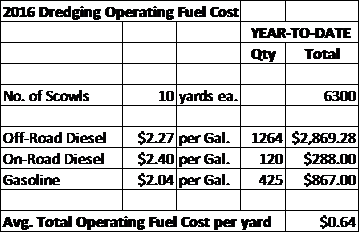
I would like to add the maintenance crew continuously looks for improvements to increase our efficiency for the dredging operation. I am also pleased to report for the 2016 season there were no injuries involved with the dredging operation or damage to any of the equipment. Within the maintenance department safety is our number one priority on all of the projects and tasks done here at Roaming Shores.
I would also like to mention that many residents took advantage of the topsoil and fill dirt that was made available to the residents free of charge that was located at the maintenance garage. Some residents came to pick up truckloads of material and other residents came with just a 5 gallon bucket to be filled. That service will be available again this year. We will keep material stored this season again at the maintenance garage free of charge for the association members. Looking forward to a successful 2017 season!
